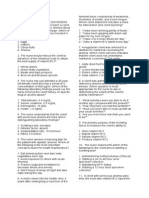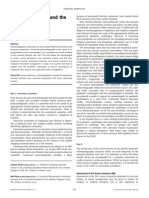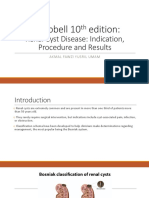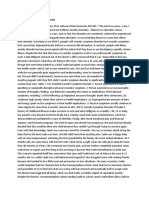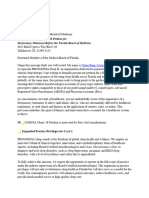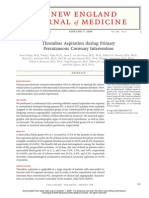Professional Documents
Culture Documents
ASCO Poster Prolonged Survival in Control Arm Sip-T (Gomella) 20111
Uploaded by
mhopkins7751Original Description:
Copyright
Available Formats
Share this document
Did you find this document useful?
Is this content inappropriate?
Report this DocumentCopyright:
Available Formats
ASCO Poster Prolonged Survival in Control Arm Sip-T (Gomella) 20111
Uploaded by
mhopkins7751Copyright:
Available Formats
Post-Progression Treatment with APC8015F may have Prolonged Survival of Subjects in the Control Arm of Sipuleucel-T Phase 3 Studies
L.G. Gomella1, C. Nabhan2, J.B. Whitmore3, M.W. Frohlich3, and D.J. George4 (1Jefferson Medical College, Philadelphia PA, 2Advocate Lutheran General Hospital, Park Ridge IL, 3Dendreon Corp., Seattle WA, 4Duke Univ., Durham NC)
Introduction
Sipuleucel-T is an autologous cellular immunotherapy FDA approved for the treatment of asymptomatic or minimally symptomatic metastatic castrate resistant (hormone refractory) prostate cancer (mCRPC). Integrated results from 3 randomized, double blind, controlled Phase 3 studies provided evidence of survival prolongation in the study population (HR=0.735 [95% CI: 0.613, 0.882]; P<0.001). Control was nonactivated, autologous peripheral blood mononuclear cells. Subjects with disease progression following participation in the control arm of these 3 studies could participate in a Phase 2, open-label study and receive APC8015F, an autologous immunotherapy made from cells cryopreserved at the time of control generation. Here we report an analysis of the APC8015F treatment effect across the 3 studies. Control Infusions
Results
Figure 2. Control Arm Flow Diagram
APC8015F Infusions
155 received APC8015F 61 did not receive APC8015F
Results
Figure 4. Overall Survival Following Disease Progression (Kaplan-Meier)
6 7
Results Results
Table 4. Incidence of Adverse Events with Onset 1 Day After Infusion Reported in >2% of APC8015F Subjects
Preferred Term Any Subject Reporting an AE Chills Nausea Pyrexia Fatigue Back Pain Constipation Hypertension Pain in Extremity Arthralgia Dizziness Musculoskeletal Pain Vomiting Anorexia Weight Decreased Control1 (N=244) n (%) 126 (51.6) 11 (4.5) 6 (2.5) 5 (2.0) 37 (15.2) 11 (4.5) 7 (2.9) 2 (0.8) 11 (4.5) 9 (3.7) 1 (0.4) 7 (2.9) 2 (0.8) 3 (1.2) 3 (1.2) APC8015F (N=165) n (%) 71 (43.0) 23 (13.9) 13 (7.9) 13 (7.9) 10 (6.1) 8 (4.8) 6 (3.6) 6 (3.6) 6 (3.6) 5 (3.0) 5 (3.0) 5 (3.0) 5 (3.0) 4 (2.4) 4 (2.4) Sipuleucel-T1 (N=485) n (%) 390 (80.4) 254 (52.4) 64 (13.2) 114 (23.5) 88 (18.1) 20 (4.1) 6 (1.2) 25 (5.2) 9 (1.9) 21 (4.3) 22 (4.5) 7 (1.4) 41 (8.5) 12 (2.5) 5 (1.0)
8
Randomization to control group
249 control subjects in 3 mCRPC studies
216 with confirmed disease progression*
*10 control subjects did not have confirmed disease progression and were treated with APC8015F
Methods
Figure 1. Trial Design: Studies D9901, D9902A, and IMPACT
Sipuleucel-T Q2 weeks x3 Asymptomatic or Minimally Symptomatic1, Metastatic, Castrate Resistant Prostate Cancer P R O G R E S S I O N Treated at Physicians Discretion Treated at Physicians Discretion, Including Optional Entry into a Phase 2 Open-Label Study2 S U R V I V A L
Median time from randomization to first APC8015F infusion was 5.2 months (range 1.8-33.1) Median time from disease progression to first APC8015F infusion was 2.2 months (range 0.5-14.6)
Sipuleucel-T: median survival time 20.7 months Control With APC8015F: median survival time 20.0 months Control Without APC8015F: median survival time 9.8 months
Table 1. Baseline Characteristics
Characteristic Age, median (range, years) Weight ,median (range, lbs) Race, Caucasian, n (%) ECOG Performance Status = 0, n (%) Gleason Sum, n (%) 7 8 Number of bone metastases, n (%) 0-5 6-10 > 10 56 (66.7) 28 (33.3) 33 (39.3) 10 (11.9) 40 (47.6) 117.0 12.6 196.0 62.1 115 (69.7) 49 (29.7) 79 (47.9) 29 (17.6) 57 (34.5) 97.0 12.9 184.0 40.8 351 (72.0) 136 (27.9) 206 (42.2) 67 (13.7) 211 (43.2) Control (N=84) 71 (53-89) 186 (135-300) 78 (92.9) 59 (70.2) APC8015F (N=165) 70 (40-87) 191 (132-282) 151 (91.5) 140 (84.8) Sipuleucel-T1 (N=488) 72 (47-91) 194 (116-384) 437 (89.5) 393 (80.5)
Control Q2 weeks x3
Endpoints for D9901 and D9902A Primary:Time to Disease Progression Planned Analysis: Overall Survival
1Studies
Endpoints for IMPACT Primary: Overall Survival Secondary: Time to Objective Disease Progression
APC8015F-treated control subjects had improved post-progression survival relative to untreated control subjects. Because APC8015F-treated control subjects had more favorable baseline characteristics, modeling approaches to adjust for baseline and post-progression covariates were therefore undertaken.
AEs from safety population of studies D9901, D9902A, and IMPACT 1 day after initial infusion of sipuleucel-T or control. Table ordered by APC8015F events.
Summary
APC8015F-treated control subjects had improved post-progression survival relative to untreated control subjects, which persisted after adjusting for baseline and post-progression variables Cumulative CD54 upregulation and TNC count product parameters were correlated with survival in APC8015F-treated control subjects, consistent with correlations observed between product parameters and survival for sipuleucel-T subjects APC8015F-treated control subjects generally experienced more of the most common AEs than untreated control subjects and fewer of the most common AEs than subjects treated with sipuleucel-T
D9901 and D9902A enrolled only asymptomatic subjects 2 Treatment with APC8015F under salvage protocol D9903 for subjects from studies D9901 and D9902A, and salvage Baseline Laboratory Results Alkaline phosphatase, median (U/L) protocol PB01 for subjects from the IMPACT study
Table 2. Modeling Approaches
103 .0 12.9 190.0 51.5
Unadjusted Adjusted for baseline PSA and LDH Adjusted for baseline age, PSA, LDH, and post-randomization docetaxel use HR=0.52 (95% CI: 0.37, 0.73); P=0.0001 HR=0.56 (95% CI: 0.40, 0.80); P=0.001 HR=0.55 (95% CI: 0.39, 0.78); P<0.001 Post-progression APC8015F effect in control subjects (log rank test, Cox regression)
Analysis of APC8015F Treatment Effect Across Studies D9901, D9902A, and IMPACT
APC8015F is an autologous immunotherapy made from cells cryopreserved at the time of control generation and required to meet the same potency specifications (CD54 upregulation) as sipuleucel-T Disease progression was evaluated by imaging studies (bone scan and CT) and confirmed by independent, blinded review committees Following disease progression, subjects in the control arms of D9901, D9902A, and IMPACT were offered 3 infusions of APC8015F Baseline characteristics and adverse events (AEs) were reported in the APC8015F group for any subject who received at least one infusion of APC8015F whether or not disease progression was confirmed APC8015 treatment effect analyses were performed using data from control subjects with confirmed disease progression
Hemoglobin, median (g/dL) Lactate dehydrogenase, median (U/L) Serum PSA, median (ng/mL)
1Baseline
characteristics are reported for all randomized subjects from the 3 mCRPC studies.
2 3
Figure 3. Overall Survival from Randomization (Kaplan-Meier)
Adjusted for independent predictors of overall survival and with APC8015F treatment and docetaxel as time dependent covariates1 APCF8015F treatment effect Docetaxel effect HR=0.78 (95% CI: 0.54, 1.11); P=0.17 HR=0.86 (95% CI: 0.60, 1.22); P=0.40
Independent baseline predictors were determined by backwards stepwise method, and included lower LDH, alkaline phosphatase, ECOG status, age, number of bone metastases, and higher hemoglobin
Conclusions
There is no evidence that treatment with APC8015F adversely affected outcome APC8015F demonstrated evidence of clinical activity
Associated with longer survival Demonstrated modest treatment-related AEs Cumulative CD54 upregulation correlated with prolonged survival
Sipuleucel-T: median survival time 25.4 months Control With APC8015F: median survival time 23.6 months Control Without APC8015F: median survival time 12.7 months
Docetaxel was received post-randomization in 78/155 (50.3%) of APC8015F-treated control subjects and in 28/61 (45.9%) of untreated control subjects
Statistical Analyses of Overall Survival Following Disease Progression
Unadjusted analysis based on Cox model (stratified by study D9903 or PB01) and the 4 log-rank test Stratified Cox regression model adjusted for baseline PSA and LDH Stratified Cox regression model adjusted for baseline age, PSA, LDH, and postrandomization docetaxel use (yes/no) Model-based analysis using backward selection to identify significant (P<0.10) baseline prognostic variables. Post-randomization APC8015F treatment and docetaxel use were fit as time dependent co-variates, and were retained in the model
Table 3. Cumulative Product Parameters
Correlation with Overall Survival Subsequent to First APC8015F Infusion1 (n=155) Median CD54 upregulation (fold) CD54 counts (x 109) Total nucleated cell count (x 109) 21.98 0.50 1.90 HR 0.555 0.916 0.751 95% CI 0.322, 0.958 0.732, 1.145 0.571, 0.987 P value 0.03 0.44 0.04
To eliminate the effect of variability in time to disease progression (at which point the control subjects became eligible to receive APC8015F), an analysis of survival subsequent to disease progression was undertaken (Figure 4).
HR, 95% CI, and p-value from Cox regression model with log-transformed cumulative product parameter adjusted for log-transformed baseline PSA and LDH, stratified by salvage protocol D9903 or PB01.
APC8015F may have prolonged survival of the control arm in the three Phase 3 studies of sipuleucel-T, potentially diminishing the observed survival benefit
Contact: Daniel J. George, MD (daniel.george@duke.edu) PP-1940.00 02JUN11
You might also like
- The Subtle Art of Not Giving a F*ck: A Counterintuitive Approach to Living a Good LifeFrom EverandThe Subtle Art of Not Giving a F*ck: A Counterintuitive Approach to Living a Good LifeRating: 4 out of 5 stars4/5 (5783)
- The Yellow House: A Memoir (2019 National Book Award Winner)From EverandThe Yellow House: A Memoir (2019 National Book Award Winner)Rating: 4 out of 5 stars4/5 (98)
- Never Split the Difference: Negotiating As If Your Life Depended On ItFrom EverandNever Split the Difference: Negotiating As If Your Life Depended On ItRating: 4.5 out of 5 stars4.5/5 (838)
- Shoe Dog: A Memoir by the Creator of NikeFrom EverandShoe Dog: A Memoir by the Creator of NikeRating: 4.5 out of 5 stars4.5/5 (537)
- The Emperor of All Maladies: A Biography of CancerFrom EverandThe Emperor of All Maladies: A Biography of CancerRating: 4.5 out of 5 stars4.5/5 (271)
- Hidden Figures: The American Dream and the Untold Story of the Black Women Mathematicians Who Helped Win the Space RaceFrom EverandHidden Figures: The American Dream and the Untold Story of the Black Women Mathematicians Who Helped Win the Space RaceRating: 4 out of 5 stars4/5 (890)
- The Little Book of Hygge: Danish Secrets to Happy LivingFrom EverandThe Little Book of Hygge: Danish Secrets to Happy LivingRating: 3.5 out of 5 stars3.5/5 (399)
- Team of Rivals: The Political Genius of Abraham LincolnFrom EverandTeam of Rivals: The Political Genius of Abraham LincolnRating: 4.5 out of 5 stars4.5/5 (234)
- Grit: The Power of Passion and PerseveranceFrom EverandGrit: The Power of Passion and PerseveranceRating: 4 out of 5 stars4/5 (587)
- Devil in the Grove: Thurgood Marshall, the Groveland Boys, and the Dawn of a New AmericaFrom EverandDevil in the Grove: Thurgood Marshall, the Groveland Boys, and the Dawn of a New AmericaRating: 4.5 out of 5 stars4.5/5 (265)
- A Heartbreaking Work Of Staggering Genius: A Memoir Based on a True StoryFrom EverandA Heartbreaking Work Of Staggering Genius: A Memoir Based on a True StoryRating: 3.5 out of 5 stars3.5/5 (231)
- On Fire: The (Burning) Case for a Green New DealFrom EverandOn Fire: The (Burning) Case for a Green New DealRating: 4 out of 5 stars4/5 (72)
- Elon Musk: Tesla, SpaceX, and the Quest for a Fantastic FutureFrom EverandElon Musk: Tesla, SpaceX, and the Quest for a Fantastic FutureRating: 4.5 out of 5 stars4.5/5 (474)
- The Hard Thing About Hard Things: Building a Business When There Are No Easy AnswersFrom EverandThe Hard Thing About Hard Things: Building a Business When There Are No Easy AnswersRating: 4.5 out of 5 stars4.5/5 (344)
- The Unwinding: An Inner History of the New AmericaFrom EverandThe Unwinding: An Inner History of the New AmericaRating: 4 out of 5 stars4/5 (45)
- The World Is Flat 3.0: A Brief History of the Twenty-first CenturyFrom EverandThe World Is Flat 3.0: A Brief History of the Twenty-first CenturyRating: 3.5 out of 5 stars3.5/5 (2219)
- The Gifts of Imperfection: Let Go of Who You Think You're Supposed to Be and Embrace Who You AreFrom EverandThe Gifts of Imperfection: Let Go of Who You Think You're Supposed to Be and Embrace Who You AreRating: 4 out of 5 stars4/5 (1090)
- The Sympathizer: A Novel (Pulitzer Prize for Fiction)From EverandThe Sympathizer: A Novel (Pulitzer Prize for Fiction)Rating: 4.5 out of 5 stars4.5/5 (119)
- Her Body and Other Parties: StoriesFrom EverandHer Body and Other Parties: StoriesRating: 4 out of 5 stars4/5 (821)
- Pulmonary AngiographyDocument3 pagesPulmonary AngiographyBiway RegalaNo ratings yet
- Ointments, Creams and GelsDocument109 pagesOintments, Creams and GelsAllyson Carlos100% (1)
- Muscle of The SoulDocument3 pagesMuscle of The SoulIrmak AlevNo ratings yet
- Nclex Hema and CardioDocument9 pagesNclex Hema and CardioDefensor Pison GringgoNo ratings yet
- Bimbingan Dokter Hari - CKDDocument24 pagesBimbingan Dokter Hari - CKDVicky LumalessilNo ratings yet
- Metabolic Bone DisordersDocument24 pagesMetabolic Bone Disordersbpt20% (1)
- Alzheimer's Disease Research PaperDocument10 pagesAlzheimer's Disease Research PaperHeidi Czaplewski100% (1)
- Promoting Rational Medicine UseDocument69 pagesPromoting Rational Medicine UseIvan Danusaputra100% (1)
- 1echocardiography and The NeonatologistDocument4 pages1echocardiography and The NeonatologistAbuAlezzAhmedNo ratings yet
- 300 Video Lectures About Narcissists and PsychopathsDocument20 pages300 Video Lectures About Narcissists and PsychopathsSam VakninNo ratings yet
- Neuromuscular QuestionsDocument9 pagesNeuromuscular QuestionsLily JenNo ratings yet
- Attending Osteomyelitis ModuleDocument9 pagesAttending Osteomyelitis ModuleMrLarry DolorNo ratings yet
- Campbell 10 Edition:: Renal Cyst Disease: Indication, Procedure and ResultsDocument13 pagesCampbell 10 Edition:: Renal Cyst Disease: Indication, Procedure and ResultsAkmal FawziNo ratings yet
- Pulmonary Congestion Secondary To PneumoniaDocument104 pagesPulmonary Congestion Secondary To PneumoniaAubrey Unique EvangelistaNo ratings yet
- Drug Studies For Muscular and Lymphatic SystemDocument6 pagesDrug Studies For Muscular and Lymphatic SystemLili M.No ratings yet
- File1-Role of Nurse in EpidemiologyDocument14 pagesFile1-Role of Nurse in EpidemiologyRufus Raj83% (23)
- CASE 7 Somatic Symptom DisorderDocument11 pagesCASE 7 Somatic Symptom DisorderApril AstilloNo ratings yet
- Pharmaceutical dosage capsules tabletsDocument6 pagesPharmaceutical dosage capsules tabletsLena EmataNo ratings yet
- Principles of Management of Poisoned Patient: 09/09/1440 DR Abdelmonem G. Madboly 1Document19 pagesPrinciples of Management of Poisoned Patient: 09/09/1440 DR Abdelmonem G. Madboly 1JyotiNo ratings yet
- Avoiding Blood Gases Errors Handbook PDFDocument20 pagesAvoiding Blood Gases Errors Handbook PDFkinnusaraiNo ratings yet
- Intersect ENT Investor Presentation - $XENTDocument28 pagesIntersect ENT Investor Presentation - $XENTmedtechyNo ratings yet
- Appstat PDFDocument197 pagesAppstat PDFrfactor0976No ratings yet
- Intravenous Nutrient TherapyDocument15 pagesIntravenous Nutrient TherapySuresh IndiaNo ratings yet
- Authorization Letter RaviDocument1 pageAuthorization Letter RaviTanmoy Pal ChowdhuryNo ratings yet
- Euthanasia ThesisDocument11 pagesEuthanasia ThesisAyush MathurNo ratings yet
- Check Your English Vocabulary For MedicineDocument65 pagesCheck Your English Vocabulary For MedicineOlga Poleszak100% (1)
- CAA Declaratory StatementDocument2 pagesCAA Declaratory StatementAndrew WilsonNo ratings yet
- Principles of Practice For Pharmaceutical CareDocument29 pagesPrinciples of Practice For Pharmaceutical CareNgetwa TzDe TheWirymanNo ratings yet
- Journal Club: Dr. Shereen S. LucmanDocument36 pagesJournal Club: Dr. Shereen S. LucmanShereen DS LucmanNo ratings yet
- New England Journal Medicine: The ofDocument11 pagesNew England Journal Medicine: The ofahmadto80No ratings yet












































